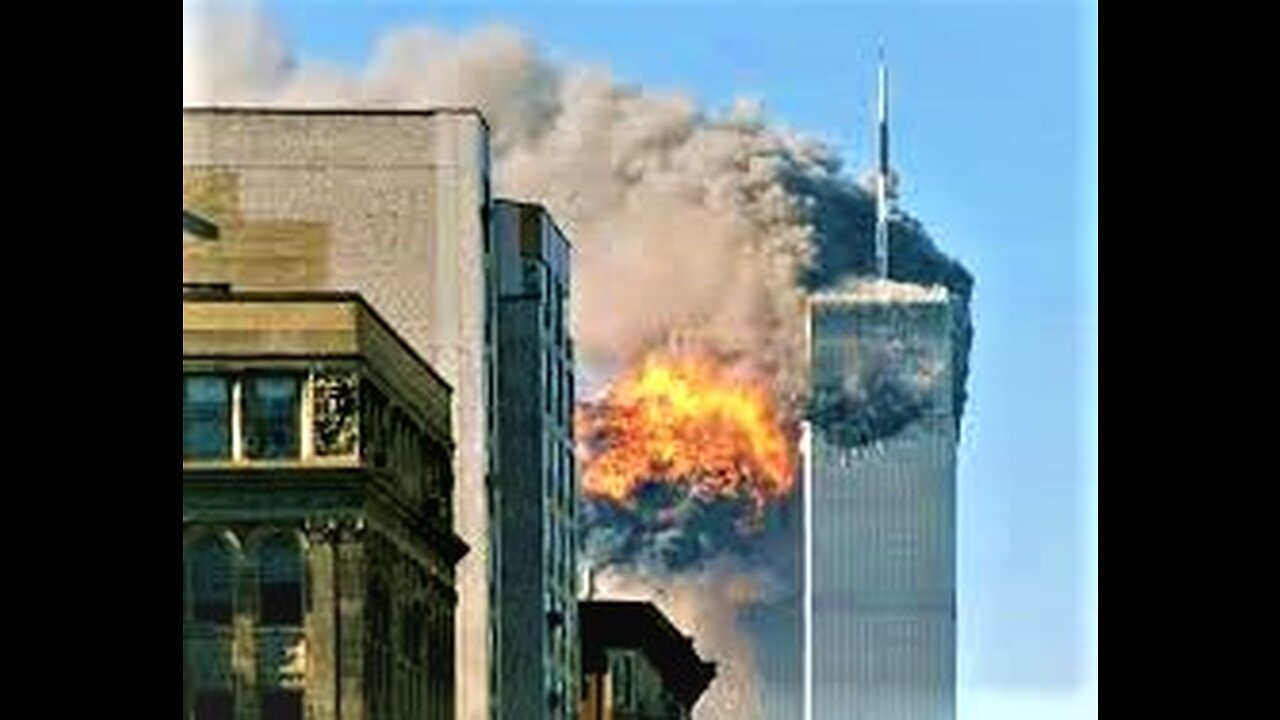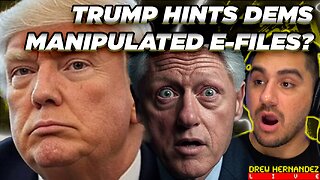Premium Only Content

White Fear Mongering: from Communism to Terrorism
Communists, and Terrorists: Evaluating the Risks and Tallying the Costs
The risk from terrorism, like that from witches and domestic Communists in the past, has been massively exaggerated, but it has only very rarely been explained or even examined by those who are appalled at the security system those exaggerations have spawned.
In contrast, as with the hunts for witches and Communists, the chief challenge to the domestic counter-terrorism system in the United States is at what might be called the “periphery.” Thus, concerns are raised about prosecutorial misconduct, the potential entrapment or misidentification of suspects, and the legality of the Guantanamo Bay, Cuba, detention facility.
These are entirely legitimate concerns, of course, but ones likely to be ineffective in front of judges anxious to set deterring sentences and juries composed of frightened citizens.
No defense of civil liberties is likely to be terribly effective as long as people believe the threat from terrorism is massive, even existential.
To undo, or even modify, the security system that has burgeoned in the United States during the last ten years, those who oppose it must attack not simply the consequences of the system, but also the premise that furnishes its essential engine.
“Threats” of the Past
Between about 1480 and 1680, hundreds of thousands of people, the vast majority of them women, were executed in Europe, mostly by being burned at the stake.
This took place after they had confessed, generally (but not always) under torture, to such crimes as eating babies, flying on broomsticks, and copulating with devils.
Notes historian Hugh Trevor-Roper (in The European Witch-Craze of the Sixteenth and Seventeenth Centuries (1969), one square in a German town “looked like a little forest, so crowded were the stakes,” and during an eight-year reign one prince-bishop “burnt 900 persons, including his own nephew, nineteen Catholic priests, and children of seven who were said to have had intercourse with demons.”
During this long period, a few people tried to debunk the process—and some were tortured and executed themselves because of such heresy.
But their attacks on it were ineffectual because they went after the consequences of the system, not its premise: that witches exist and that they are a key element in an ongoing battle on earth between God and the Devil.
Let us flash forward. In his fascinating 2000 book Communazis, Alexander Stephan describes the U.S. government’s surveillance of a group of émigré writers during and after World War II. None was found to pose much of a subversive threat, and the surveillance never led to real persecution—indeed, few of the writers noticed they were being watched. Instead, what impresses Stephan is the essential absurdity of the situation, as huge numbers of government employees intercepted and catalogued communications, meticulously recorded comings and goings, and sifted enterprisingly through trash bins, exhibiting a “combination of high efficiency with grotesque overkill”—and all, of course, “at taxpayers’ expense.”
At the time, critics of this process, like those for the witch craze, focused almost entirely on the potential for civil liberties violations. But no one, it seems, attacked the premise of the system—that Communists were everywhere and posed a severe threat. More specifically, at no point during the Cold War does it appear that anyone said in public “many domestic Communists adhere to a foreign ideology that ultimately has as its goal the destruction of capitalism and democracy and by violence if necessary; however, they do not present much of a danger, are actually quite a pathetic bunch, and couldn’t subvert their way out of a wet paper bag. Why are we expending so much time, effort, and treasure over this issue?”
In fact, despite huge anxieties about it at the time, there seem to have been few, if any, instances in which domestic Communists engaged in anything that could be considered espionage after the Second World War. Moreover, at no time did any domestic Communist ever commit anything that could be considered violence in support of the cause.
Nonetheless, the fear of domestic Communism and the consequent costly anti-Communist surveillance system persisted for decades. Thus, in 1972, the Federal Bureau of Investigation (FBI) in full perpetual motion mode opened 65,000 new files as part of its costly quest to ferret out Communists in the United States. The pursuit died out only when international Communism collapsed at the end of the Cold War.
Terrorist Risks Assessed
Something comparable has now happened for the terrorist threat, and key to its dynamic is that Americans apparently continue to remain unimpressed by several inconvenient facts:
There have been no al-Qaeda attacks whatsoever in the United States since 2001
No true al-Qaeda cell (nor scarcely anybody who might even be deemed to have a “connection” to the diabolical group) has been unearthed in the country.
Since 9/11, the number of homicides committed by Muslim extremists within the United States represents one-fiftieth of 1 percent of the total.
The homegrown “plotters” who have been apprehended, while perhaps potentially somewhat dangerous at least in a few cases, have mostly been flaky or almost absurdly incompetent.
The total number of people killed worldwide by al-Qaeda types, maybes, and wannabes outside of war zones since 9/11 stands at some 300 or so a year (smaller than the yearly number of bathtub drownings in the United States alone).
Unless the terrorists are able somehow massively to increase their capacities (and, if anything, attacks have declined in intensity and sophistication), the likelihood a person in the United States will perish at the hands of an international terrorist over an eighty-year period is about one in 85,000 (as compared to one in 100 for perishing in an automobile crash).
Instead, the public has chosen, it appears, to wallow in what philosopher Leif Wenar has labeled a false sense of insecurity.
Accordingly, the public will presumably continue to demand that its leaders pay due deference to its insecurities and will uncritically approve as huge sums of money are shelled out in a quixotic and often mostly symbolic effort to assuage those insecurities.
Accordingly, agencies like the FBI have redirected much of their effort from such unglamorous enterprises as dealing with organized crime and white-collar embezzlement to focus primarily on the terrorist threat.
Like their predecessors during the quests to quash witchery and domestic Communism, they have dutifully and laboriously assembled masses of intelligence data and have pursued an endless array of leads. Almost all of this activity has led nowhere, but it will continue because, of course, no one wants to be the one whose neglect somehow leads to “another 9/11.”
Despite the importance of a responsible policy of seeking to communicate risk, and despite the costs of irresponsible fear-mongering, just about the only official who has ever openly put the threat presented by terrorism in some sort of context is New York’s Mayor Michael Bloomberg, who in 2007 pointed out that people should “get a life” and that they have a greater chance of being hit by lightning than of being struck by terrorism—an observation that is a bit off the mark, but roughly sound.
Or, put more broadly, the continual question, “are we safer?” is never answered with: “At present rates, your chances of being killed by a terrorist are about one in 3.5 million per year; how much safer do you want to be?”
Instead, the fear of terrorism, stoked during the George W. Bush administration and still promoted under Barack Obama, goes almost completely unexamined by pundits and the press.
In 2008, then Department of Homeland Security Secretary Michael Chertoff uttered the bizarre, if exquisitely nuanced, observation to a couple of reporters that the threat from terrorism is “a significant existential” one.
And at a recent press conference, current Homeland Security chief Janet Napolitano opaquely announced that, though the likelihood of a large-scale organized attack is diminished, the continued danger of a small-scale disorganized attack means that the terrorist threat is higher than at any time since 9/11.
Neither contention prompted skeptical query from their rapt auditors.
The point is not that there is nothing to find, but that excesses can only be reduced if the internalized hysteria about terrorism is substantially dampened.
If people have come to believe that the chance every year of being killed by a terrorist is dangerously high (rather than one in 3.5 million), they are unlikely to be moved by concerns about Miranda rights.
In addition to a sensible assessment of the limited risk terrorism presents, there ought to be a systematic effort to evaluate the costs of homeland security spending.
These costs, like those entailed in the hunts for witches and domestic Communists, have become massive. Tallying the expenditures on domestic homeland security and adding in opportunity costs—but leaving out related overseas costs such as those entailed by the terrorism-induced wars in Iraq and Afghanistan—the increase in expenditures on domestic homeland security during the past decade exceeds $1 trillion.
As author Alexander Stephan might amazedly suggest, taxpayers really ought to take note.
But no one has really been doing so, something noted in a 2010 report of the National Academy of Sciences that assesses the Department of Homeland Security (DHS). Unable to “find any DHS risk analysis capabilities and methods that are yet adequate for supporting DHS decision making” on terrorism, it notes that “little effective attention was paid to the features of the risk problem that are fundamental.” This is particularly impressive because, as the report also notes, risk and cost-benefit analyses of natural hazards conducted within the same department are state of the art.
Overall, it seems, security concerns that happen to rise to the top of the agenda are serviced without much in the way of full evaluation—security trumps economics, as one insider puts it—and such key issues as acceptable risk are rarely discussed while extravagant worst-case scenario thinking dominates, and frequently savagely distorts, the discussion. Management, as the president of the RAND Corporation has suggested, is “by inbox.”
Homeland Security Costs Examined
It is clearly time to examine the massive increases in homeland security expenditures (increases mainly, of course, impelled by escalated concerns about terrorism) in a careful and systematic way. This would involve applying the kind of analytic risk management approaches emphasizing cost-benefit analysis and determinations of acceptable and unacceptable risks that are routinely required of other governmental agencies and that have been standard coin for policy decision making for decades throughout the world when determining regulations and expenditures.
These approaches have been successfully applied even in such highly charged and politicized decisions as those regarding where to situate nuclear power plants, how to dispose of toxic waste, and how to control pollution.
When these standard procedures are applied, it is discovered in order for enhanced U.S. expenditures on homeland security to be deemed cost-effective, they would have had to deter, prevent, foil, or protect against 1,667 otherwise successful car bomb attacks (something like the one attempted on Times Square in 2010) per year, or more than four per day.
And it appears that the protection of a standard office-type building would be cost-effective only if the likelihood of a sizable terrorist attack on the building is a thousand times greater than it is at present. Something similar holds for the protection of bridges. On the other hand, hardening cockpit doors on airliners may be cost-effective, though the provision for air marshals on the planes is decidedly not.
Not only has the DHS failed to do such standard and straight-forward analyses of risks and costs, but it also has at times ignored calls by other government agencies to do so. In 2010, the department began deploying full-body scanners at airports, a technology that will cost $1.2 billion per year.
The Government Accountability Office (GAO) specifically declared that conducting a cost-benefit analysis of this new technology to be “important.” As far as the authors can tell, no such study was conducted (in our analysis, the cost-effectiveness of the technology is questionable at best). Or there was GAO’s request that the DHS conduct a full cost-benefit analysis of the extremely costly process of scanning 100 percent of U.S.-bound containers. To do so would require the dedicated work of a few skilled analysts for a few months or possibly a year.
Yet, the DHS replied that, although it agreed that such a study would help “frame the discussion and better inform Congress,” to actually carry it out “would place significant burdens on agency resources.”
In the end, one might darkly suspect, such evasions are grasped because, if realistic probabilities that a given target would be struck by terrorists were multiplied into the risk calculation and if the costs of protection from unlikely threats were sensibly calculated following standard procedures, it would be found that a vast amount of money has been misspent.
Politicians and bureaucrats do, of course, face considerable political pressure on the terrorism issue. However, although political pressures may force actions and expenditures that are unwise, they usually do not precisely dictate the level of expenditure. Thus, although there are public demands to “do something” about terrorism, nothing in that demand specifically necessitates removing shoes in airport security lines, requiring passports to enter Canada, spreading bollards like dandelions, or making a huge number of buildings into forbidding fortresses.
The United Kingdom, which seems to face an internal threat from terrorism that is considerably greater than that for the United States, appears nonetheless to spend proportionately much less than half as much on homeland security, and the same holds for Canada and Australia. Yet politicians and bureaucrats there do not seem to suffer threats to their positions or other political problems because of it.
And while political and public pressure furnish an understandable excuse for expending money, it is not a valid one: It does not relieve officials of the responsibility of seeking to expend public funds wisely. This is particularly the case in matters of public safety—domestic tranquility—the most fundamental function of government. To adopt measures that protect people at high cost while neglecting ones that may save far more lives at far lower cost is irresponsible, even immoral. And to do so without applying standard evaluative aids to decision making that have been developed and used in other areas for decades is even more so.
To be irrational with your own money may be to be foolhardy, to give in to guilty pleasure, or to wallow in caprice. But to be irrational with other people’s money is to be irresponsible, to betray an essential trust. In the end, it becomes a dereliction of duty that cannot be justified by political pressure, bureaucratic constraints, or emotional drives.
========
Desperate Establishment resorts to fear-mongering
A gost is haunting Britain’s right-wing newspapers — the gost of desperation.
Devoid of credibility and condemned to watch the slow collapse of their neoliberal weltanschauung (world outlook), it seems all they have left to exploit is the power of fear.
“Commie spy,” “loony lefty,” “traitor,” “Britain-hating ideologue,” “terrorist sympathizer” and “threat to our national security.”
These are just a few of the desperately absurd scare-terms the right-wing press has tried to pin on Jeremy Corbyn over the past few years.
Of course, none of it should be a surprise. The incessant attempts to associate him with “communists” and “terrorists” and various kinds of bogeymen are in fact standard protocol for an Establishment feeling deeply threatened.
In a study Taking the Risk out of Democracy:
Corporate Propaganda Versus Freedom and Liberty, Carey lucidly documented the rise of corporate propaganda in the US during the 20th century
He showed how the extension of the popular franchise — that is, the spread of democracy — and the growth of trade union movements at the turn of the century led to a shift of power into the hands of public opinion and organized labor.
This threatened existing power and privilege, which, as he put it, responded by co-ordinating sophisticated propaganda campaigns to suppress “democratic aspirations and the interests of larger public purposes” and protect their own socio-economic interests.
The campaigns were devastatingly successful
Labor movements were quelled and democracy and civil liberties weakened
The period became known as the first red scare.
One of the means by which this scare was promoted was through the deliberate creation and preservation of symbols designed to exacerbate national hopes and fears.
Evangelical religious beliefs, for example, which had always been deeply ingrained in US society, were invoked, with dichotomies between God/Devil and good/evil used to frame secular political and economic issues.
This manifested itself most notably in efforts to depict communism and socialism as evil and capitalism and free-enterprise as good.
Business interests went to great lengths to symbolically identify the latter with “social harmony, freedom, democracy, the family, the church and patriotism” and to associate trade unions, welfare and government regulation of business with all things evil and menacing.
The emotional and psychological power of these symbols, Carey argues, grew to become a highly effective means of social control in the 20th century, invoked again, most notably, during the second red scare of the late 1940s and ’50s — also known as the McCarthy era).
Edward S Herman and Noam Chomsky, in their seminal work Manufacturing Consent: The Political Economy of the Mass Media, would later refer to this method of social control as “anti-communism.”
They argued that Western media’s consistent publicizing of the conflicts and crimes of communist states ahead of those of non-communist states helped elevate opposition to communism to a “first principle of Western ideology and politics.”
Labeling people communists, they wrote, “helps mobilize the populace against an enemy and because the concept is fuzzy it can be used against anybody advocating policies that threaten property interests or support accommodation with communist states and radicalism. It therefore helps fragment the left and labor movements and serves as a political-control mechanism.”
Of course, this is exactly what has been happening with Corbyn in recent years. “Comrade Corbyn,” “Marxist,” “Trotskyite,” “Red Jez,” “Loony Lefty” and, most recently, “Commie Spy” are just a few of the labels deployed to evoke the deeply entrenched ideology of anti-communism.
Just as in the US, there is a long tradition of this in Britain. Scholars such as Andrew Defty, for example, have shown how consecutive British governments formed a “close and continuous liaison” with the US during the cold war to disseminate anti-communist propaganda both at home and abroad — see his work Britain, America, and Anti-Communist Propaganda, 1945-53.
And in their book Culture Wars: The Media and the British Left, media scholars James Curran, Ivor Gaber and Julian Petley identify a lineage of anti-communist demonization within the British press, which has regularly tarred political parties and individuals with the so-called “Red brush.”
This was particularly common in the Margaret Thatcher era, during which accusations of “Marxist,” “Socialist,” “Trotskyite,” and “loony lefty” were perpetually levelled at anyone showing the mildest enthusiasm for trade unions, welfare and regulation of business.
Of course, the accusations are nearly always baseless and designed to smear by association. Note the absurdity, for example, when Ed Miliband was labelled “Red Ed” by the British press, despite advocating a public sector pay freeze and proposing to cut child benefits.
Or when Barack Obama was labelled a “socialist” by Republicans, despite having bragged about achieving “the lowest level of domestic [public] spending” since the 1950s.
I’ve written previously of the anti-communist ideology in BBC Newsnight’s reporting of Syriza in 2015. Despite their advocacy of mild Keynesian economic policies, they were overwhelmingly framed as “Marxists,” “Communists” and “Trotskyites” who were disrupting European harmony.
But these days it’s not just anti-communism that is invoked to demonise inconvenient people and groups.
As Herman and Chomsky have acknowledged, in the post-Soviet era there’s been a clear shift to a more general use of fear and “othering,” which nonetheless still maintains the good/evil dichotomy.
As Chomsky explains, “You need something to frighten people with, to prevent them from paying attention to what’s really happening to them. You have to somehow engender fear and hatred, to channel the kind of fear and rage — or even just discontent — that’s being aroused by social and economic conditions.”
One of the most powerful additions to anti-communism, Herman and Chomsky write, has been the “war on terror” or “anti-terrorism.”
In the case of Corbyn, this has manifested itself in persistent efforts to associate him with the IRA, Hamas, Hezbollah, Iran and “terror” more generally.
In a 2016 study entitled Journalistic Representations of Jeremy Corbyn in the British Press: from “watchdog” to “attack dog,” media scholars at LSE found that “the British press has repeatedly associated Corbyn with terrorism and positioned him as a friend of the enemies of the UK.”
Recall also how in 2015 the Conservative Party declared him “a threat to our national security, our economic security and your family’s security’ and how David Cameron publicly accused him of having a ‘security-threatening, terrorist-sympathising, Britain-hating ideology.”
More recently, on the eve of last year’s election, the Daily Mail ran a front-page headline calling Corbyn and his colleagues “APOLOGISTS FOR TERROR,” while the Sun ran a headline that read “JEZZA’S JIHADI COMRADES.” Only a month ago we saw “CORBYN THE COLLABORATOR” and “CORBYN THE COMMIE SPY” plastered across the same front pages, respectively.
Of course, in knowing a little history it’s clear to see what’s going on here.
Just like the democratic movements of the early 20th century, Corbyn’s politics and popularity are deeply threatening to our modern corporate-media Establishment, who are desperately trying to promote fear and hatred of him through their own propaganda campaigns.
The only problem is, however, that their propaganda doesn’t seem to be working so well.
Not only has the era of social media made it possible to debunk the increasingly absurd claims they make but the Internet has broken their grip on the control of information distribution more generally.
Unsurprisingly, people are seeking and appreciating alternative information sources, as public trust in the media and politicians is now at an all time low.
But this doesn’t mean that there isn’t cause for concern. It was only a month ago, after all, that a British nationalist told a court how he’d planned to kill Corbyn because he thought he was a “traitor.”
When questioned he said:
“Oh yeah, it would be one less terrorist [on] our streets.” And it was only a year ago that the far-right killer of Labour MP Jo Cox stood in court and declared “death to traitors, freedom for Britain.”
Indeed, as the British press continues its hate-fuelled fear-mongering propaganda campaign to legitimize Corbyn, which it will almost certainly ramp up when he is in office, we would do well to know a little history on this matter.
In fact, when just over 80 per cent of our newspapers are owned by five right-wing billionaires who have every intention of controlling what we think, a little understanding of history can go a very long way indeed.
Simplicity and Spook: Terrorism and the Dynamics of Threat Exaggeration
It has been common, at least since 1945, to exaggerate and to overreact
to foreign threats, something that seems to be continuing with current
concerns over international terrorism.
This paper sketches threat ex-aggeration during the Cold War and applies the experience from that era to the current one.
Alarmism and overreaction can be harmful, particularly economically.
And, in the case of terrorism, it can help create the damaging consequences the terrorists seek but are unable to perpetrate on their own.
Moreover, many of the forms alarmism has taken verge on hysteria.
The United States is hardly ‘‘vulnerable’’ in the sense that it can be toppled by dramatic acts of terrorist destruction, even extreme ones.
The country can, however grimly, readily absorb that kind of damage, and it has outlasted considerably more potent threats in the past.
Keywords: terrorism, threat perception, weapons of mass destruction
‘‘At the summit of foreign policy,’’ Warner Schilling once observed, ‘‘one
always finds simplicity and spook.’’ This observation was triggered by a
consideration of the process by which Japan and the United States managed to
go to war with each other in 1941.
Japan, he notes, launched war on the vague, unexamined hope that the United States would seek a compromise peace after being attacked, ‘‘a hope nourished in their despair at the alternatives.’’
Meanwhile, ‘‘the American opposition to Japan rested on the dubious proposition that the loss of Southeast Asia could prove disastrous for Britain’s war effort and for the commitment to maintain the territorial integrity of ChinaFa commitment as mysterious in its logic as anything the Japanese ever conceived.’’
And at no time, he notes, did American leaders ‘‘perplex themselves with the question of just how much American blood and treasure the defense of China and Southeast Asia was worth’’ (Schilling, 1965:389; see also Russett, 1972; Mueller, 1995:101–110).
It has been common, at least since 1945, for the United States to exaggerate
foreign threats, and then to overreact to them, something that seems to be con-
tinuing with current concerns over international terrorism.
Some of this proclivity may derive from the experience with Japan before World War II:
there may have been a tendency to underestimate its capacity and its willingness to take risks, and the traumatic experience of Pearl Harbor led to embracing the over-learned lesson never to do that again.
https://politicalscience.osu.edu/faculty/jmueller/ISPFIN.PDF
-
 1:32:48
1:32:48
Omar Elattar
8 months agoAndy Elliott: "Quit Your Excuses Now!" How to 10x Your Income In 12 Months!
5.06K1 -
 2:02:10
2:02:10
Inverted World Live
8 hours agoGhislaine Maxwell Gives 100 Names to DOJ | Ep. 81
280K29 -
 2:51:11
2:51:11
TimcastIRL
8 hours agoBREAKING: MASS SHOOTING ERUPTS In NYC, Police Officer SHOT, FBI On Scene | Timcast IRL
272K132 -
 14:43:03
14:43:03
ZWOGs
15 hours ago🔴LIVE IN 1440p! - EFT w/ crgoodw1n, Kingdom Come Deliverance, Splitgate 2, & More! - Come Hang Out!
60.8K2 -
 30:09
30:09
Afshin Rattansi's Going Underground
1 day agoCurtis Yarvin: ‘Trump 47 is 10x More Powerful than Trump 45’ & the TOXIC US-Israel Relationship
41.7K34 -
 3:48:08
3:48:08
Drew Hernandez
13 hours agoTRUMP HINTS DEMS COULD HAVE PLANTED FAKE EVIDENCE & MANIPULATED EPSTEIN FILES
74.1K39 -
 7:26:18
7:26:18
Eternal_Spartan
16 hours agoThe Legend of Zelda: Majoras Mask Ep. 5 | USMC Vet | Come Join the Best Chat on Rumble!!!!
39.2K5 -
 3:44:24
3:44:24
Barry Cunningham
10 hours agoBREAKING NEWS: LIVE COVERAGE OF NEW YORK POLICE OFFICERS UNDER SIEGE!
116K84 -
 2:51:25
2:51:25
The Pascal Show
8 hours ago $3.43 earnedBREAKING! Active Shooter In Midtown Manhattan NYC Multiple People Shot!
35.9K5 -
 10:25
10:25
MattMorseTV
13 hours ago $16.76 earnedVance just DROPPED a NUKE.
61.5K50